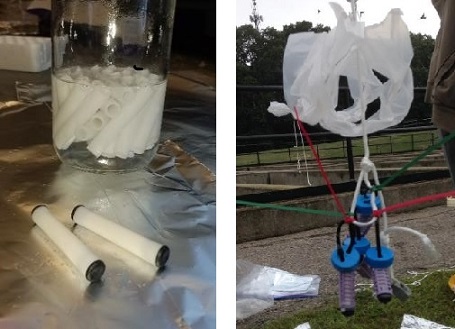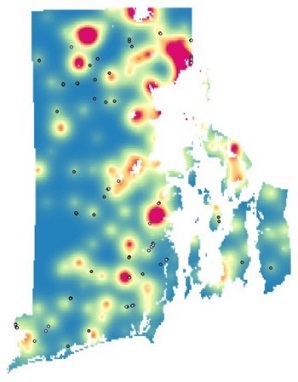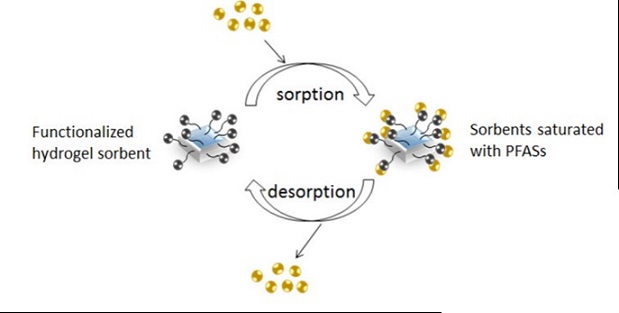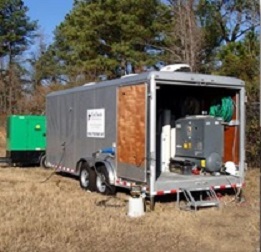Features
Innovative Approaches to Address PFAS
Superfund Research Program (SRP)-funded scientists and engineers are using innovative approaches to understand the health effects of per- and polyfluoroalkyl substances (PFAS), a large group of compounds found in aqueous film-forming foams, which have been used for fire suppression at airports, industrial facilities, and military sites, and in everyday products. They also are exploring how PFAS move and change in the environment and how to clean them up to better protect human health.
How Does PFAS Affect Health?
Because of the large number of PFAS chemicals, including perfluorooctane sulfonate (PFOS) and perfluorooctanoate (PFOA), we have many unanswered questions about their potential health effects. SRP-funded researchers are uncovering many ways PFAS exposure may cause harm.
For example, scientists at the University of Rhode Island's Sources, Transport, Exposure, and Effects of PFASs (STEEP) SRP Center have reported links between early-life PFAS exposure and immune dysfunction and metabolic abnormalities using a cohort located on the Faroe Islands. This work, led by Philippe Grandjean, D.M.Sc., M.D., is helping to establish underlying pathways to better assess how PFAS contribute to obesity and weakened immune systems. STEEP researcher Angela Slitt, Ph.D., is studying rodents to understand how PFAS exposure leads to inflammation and metabolic changes.

Former SRP researcher Rolf Halden, Ph.D., of Arizona State University, has examined the relationship between concentrations of PFOS and PFOA in cord serum, which is collected from umbilical cord blood, and birth outcomes in humans. His research showed links between higher PFOS and PFOA concentrations in cord serum and lower birthweight and birth size.
John Meeker, Sc.D., of the University of Michigan and the Northeastern University SRP Center, analyzed data from the National Health and Nutrition Examination Survey and found that PFAS exposure was associated with increased thyroid hormone levels in women. His findings suggest that exposure to PFAS may disrupt thyroid hormone balance.
Characterizing PFAS in the Environment
Accurate risk assessment and effective remediation strategies require a detailed understanding of the concentrations of PFAS in the environment, as well as information on how they move or change. SRP-funded researchers are helping to better characterize PFAS in the environment and how people are exposed.

For example, researchers at the STEEP SRP Center, led by Rainer Lohmann, Ph.D., are working to develop, test, and validate new tools to measure PFAS in the environment. One of those tools will help scientists understand how much PFAS can be taken up by organisms. They are also validating a passive polyethylene sampler that can detect certain compounds that degrade into PFAS in air and water.
In North Carolina, Lee Ferguson, Ph.D., who leads the Duke University SRP Center Analytical Chemistry Core, and colleagues discovered elevated levels of several PFAS in a lake that supplies drinking water to nearby residents and in drinking water treated by a town. Ferguson uses non-targeted approaches to identify many different contaminants in water. He also leads the PFAS Testing (PFAST) network through the North Carolina Policy Collaboratory.
Elsie Sunderland, Ph.D., of Harvard University and the STEEP SRP Center used available PFAS concentrations from several populations in the Faroe Islands to identify different chemical profiles associated with dominant exposure sources of PFAS in humans. She and her colleagues reported that individuals exposed to PFAS from seafood are identifiable by an elevated proportion of longer chain PFAS in their serum, while those exposed primarily to consumer products have relatively higher proportions of other specific PFAS chemicals.

A former postdoc at the Brown University SRP Center, Jennifer Guelfo, Ph.D., evaluated the occurrence of PFAS in water, sediment, and shellfish in Narragansett Bay. She used publicly available data to develop models that predict areas with potential PFAS groundwater contamination and reported on evaluation and management strategies for PFAS in drinking water aquifers. Led by Scott Frickel, Ph.D., the Brown SRP Center team also has designed a geospatial tool and database to map and identify areas in Rhode Island that are likely to be contaminated with PFAS and other hazards.
Innovative Approaches to Clean Up PFAS
With support from SRP, researchers and small businesses are developing tools and technologies to clean up PFAS in the environment. These approaches are critical for reducing the amount and toxicity of PFAS to better protect human health.
David Sedlak, Ph.D., and Lisa Alvarez-Cohen, Ph.D., of the University of California (UC), Berkeley SRP Center have described how microbial communities break down PFAS in aqueous film-forming foams (AFFFs), which have been used to suppress fires at airports, industrial facilities, and military sites. They observed important differences between the breakdown products produced in the presence of oxygen compared to those produced under conditions without oxygen and found evidence of breakdown products that could not be detected with their analytical methods. Alvarez-Cohen also reported that PFAS interfere with certain microbes breaking down trichloroethylene, a chlorinated contaminant found at Superfund sites - a finding that has important implications for cleanup. Sedlak also is leading a team that is exploring chemical treatment options, specifically heat-activated persulfate, to degrade and destroy PFAS and PFAS-containing AFFF . Their findings suggest that heat-activated persulfate is useful for treating some PFAS chemicals but may not be well suited for others.

Stephen Boyd, Ph.D., of the Michigan State University SRP Center is developing energy-efficient nanoreactors capable of breaking the strong carbon-fluorine bond that makes PFAS so persistent. He and his collaborators have reported complete defluorination of two common PFAS chemicals, perfluorooctanoic acid (PFOA) and perfluorooctanesulfonic acid (PFOS).
Texas A&M University SRP Center researchers developed hydrogel sorbents to remove long- and short-chain PFAS, including a chemical called GenX, within a matter of hours. The sorbents are reusable and readily regenerated.

SRP-funded small businesses EnChem Engineering, Cyclopure, and Lynntech are also developing innovative technologies to clean up PFAS. Raymond Ball, Ph.D., of EnChem Engineering is developing a technology to cost effectively speed up the removal of PFAS from soil and groundwater. They have demonstrated high levels of PFAS removal from water. Gokhan Barin, Ph.D., of Cyclopure, Inc., is developing a novel adsorbent technology using renewable cyclodextrins derived from corn starch to capture thousands of contaminants, including PFAS. Joseph Miller, Ph.D., of Lynntech, Inc., has designed a continuous removal and disposal system that binds and breaks down contaminants into harmless byproducts. Lynntech is using this technology to develop a continuous remediation system to remove PFOS and PFOA.
to Top



